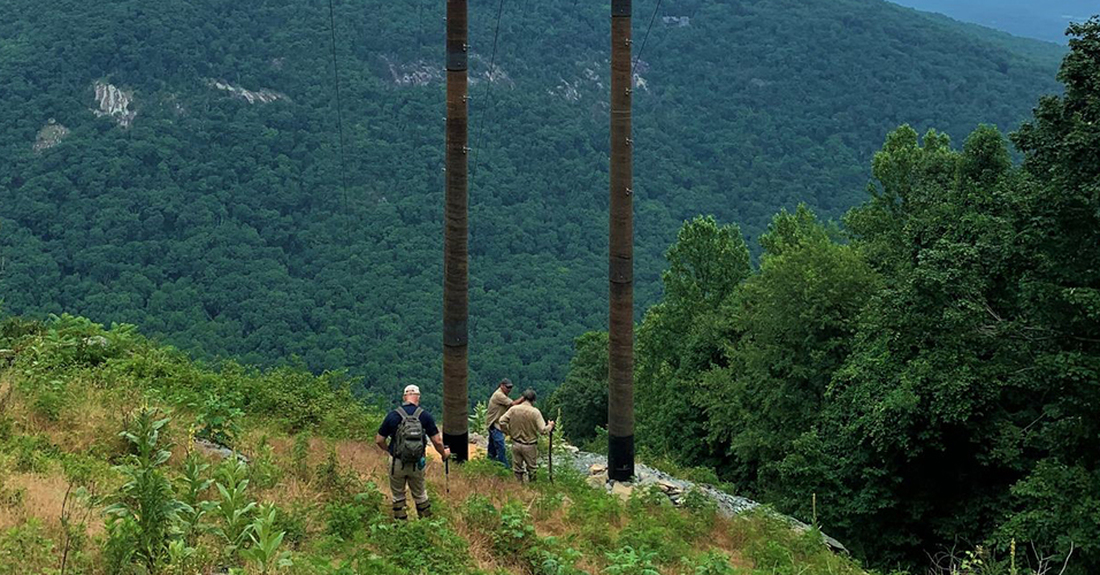
Regular utility pole inspections are at the core of maintaining the safety and functionality of electrical and communication systems. Proper inspections help identify potential hazards, structural weaknesses, and necessary repairs, reducing risks for workers and the public.
Inspectors can carry out evaluations effectively and prioritize safety by following structured procedures. This guide outlines actionable steps to achieve thorough and safe utility pole inspections.
Step 1: Assess the Surrounding Environment
Examine the area around the utility pole before starting the inspection. Hazards such as uneven terrain, traffic, or overgrown vegetation can create safety risks. A clear and safe working area improves efficiency and minimizes accidents.
Identify Environmental Risks
Analyze the ground for stability, checking for loose soil, mud, or other conditions that could compromise footing. Overhanging branches, nearby power lines, or wildlife can create additional risks.
Use brightly colored markers or cones to highlight dangerous areas and establish a safe perimeter for the inspection. Always alert coworkers to hazards to promote a collective awareness of safety concerns.
Utility pole companies like McWane Poles provide durable ductile iron utility poles designed to withstand harsh environments. These poles reduce the likelihood of unexpected structural failures, making them a reliable choice for companies seeking enhanced safety in situations where environmental impacts are pertinent.
Plan Safe Access to the Pole
Wear appropriate protective equipment, such as helmets, gloves, and nonslip footwear, to reduce risks. Before approaching, inspect the surrounding area for potential hazards, such as unstable ground, loose debris, or nearby power lines that could pose additional dangers. As you make your way to the pole, choose a clear path free of obstacles, and avoid high-traffic areas to minimize distractions.
Once at the pole, check its condition for visible damage, such as cracks, decay, or other signs of instability, to ensure it is safe for use. Finally, secure your tools and equipment properly to prevent accidental drops, and utilize climbing aids or harnesses to maintain stability and reduce the risk of falls.
Step 2: Check the Pole’s Structural Condition
Conduct a visual inspection to detect signs of damage, decay, or other structural issues. A compromised pole can pose significant risks, particularly during adverse weather or high-load scenarios. Steps for inspecting a utility pole safely include careful observation and methodical testing to identify problems early.
Recognize Signs of Decay or Damage
Examine the surface of the pole for cracks, splits, or discoloration, which often indicate internal damage. Look for signs of rot, such as spongy wood or areas where the surface appears eroded.
Pay attention to insect infestations, which can weaken the pole’s integrity. Poles exposed to excessive moisture may show fungal growth or a greenish tint, signaling potential rot.
Test for Stability
Use tools like hammers or probes to assess the pole’s stability. Gently tap the surface to identify hollow areas, which may suggest internal decay.
For a more detailed evaluation, use specialized equipment to measure structural strength. Maintain a safe distance during testing to avoid injury if the pole becomes unstable.
Step 3: Inspect Attachments and Hardware
Evaluate all hardware and attachments connected to the pole. Faulty components, such as rusted bolts or loose brackets, can compromise the pole’s overall safety. Replacing or repairing damaged hardware promptly reduces risks and extends the lifespan of the pole.
Tighten or Replace Hardware
Examine bolts, brackets, and other attachments for wear or rust. Tighten any loose components using appropriate tools, such as wrenches or pliers.
Remember to replace heavily corroded or damaged hardware immediately to maintain the pole’s structural integrity. Keep a supply of spare parts readily available to address issues during the inspection.
Evaluate Load-Bearing Capacity
Assess the ability of the attachments to support the pole’s current and future loads. Check for bending, warping, or stress marks that indicate strain on the hardware.
Consult load specifications to determine whether the hardware meets the required standards. If concerns arise, consult with a structural engineer to recommend upgrades or modifications.
Step 4: Evaluate the Electrical System
Inspect the electrical system to identify hazards or potential failures. Faulty electrical systems can disrupt operations and endanger workers, so a detailed and systematic evaluation is necessary. Use insulated tools, and follow safety protocols to minimize risks during the process.
Identify Electrical Risks
Search for visible issues such as exposed wires, cracked insulation, or discolored components that may signal electrical wear or damage. Afterward, investigate connection points for corrosion, loose fittings, or signs of overheating compromising the system’s integrity.
Then, examine nearby elements, such as grounding systems, to confirm their functionality. Include steps for inspecting a utility pole safely to mitigate risks and create actionable safety measures.
After identifying issues, categorize them by severity to prioritize repairs effectively. Maintain detailed records to track recurring problems and identify patterns that could signal larger system flaws.
Test Electrical Connections Safely
Use high-quality voltage testers to measure electrical performance without direct contact. Evaluate connections for consistent voltage output, and identify irregularities that could indicate underlying faults.
Perform resistance tests to determine if wires or connections require replacement. Pay close attention to weather conditions, as moisture and high winds can amplify electrical risks during testing.
Also, avoid working on live wires in challenging conditions; opt for dry and stable environments instead. In complex scenarios, collaborate with licensed electricians who can diagnose and repair intricate electrical issues with precision. Afterward, conduct post-repair tests to confirm the resolution of all identified problems.
Step 5: Document Findings and Plan Repairs
Detailed documentation serves as the foundation for maintenance planning and compliance. Recording observations and recommendations helps inspectors address necessary repairs and allocate resources effectively.
Create Comprehensive Inspection Records
Document all observations in well-structured reports that cover structural issues, hardware conditions, and electrical hazards in detail. Incorporate clear descriptions of each finding to ensure reports are informative and actionable.
Photographs should accompany written descriptions, capturing damage, hazards, and other relevant details to strengthen the report’s accuracy and utility. Include a prioritized list of recommended actions, such as repairs, replacements, or follow-up evaluations, to assist maintenance teams in addressing critical issues efficiently.
Use specific terminology and metrics when describing problems to help teams understand the severity and scope of each concern. In summary, creating comprehensive inspection records requires you to do the following:
- Record structural issues such as cracks, splits, or signs of decay with detailed notes.
- Attach high-resolution photographs to provide visual context for key observations.
- List and prioritize all necessary actions, starting with safety-critical repairs.
- Include metrics like load ratings or dimensions to offer measurable data.
- Organize the report into clear sections for maintenance teams to use for ease of reference.
Partner With Experts for Repairs
Engage qualified professionals to address complex repair needs. Collaboration with industry leaders, like McWane Poles, offers electric companies access to ductile iron utility poles that enhance safety and reliability. Investing in high-quality poles reduces long-term maintenance costs and promotes consistent system performance.
By following a structured process, companies can identify potential risks and implement effective solutions. Thorough inspections improve safety, extend pole longevity, and contribute to the reliability of essential infrastructure.

